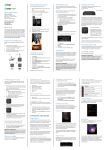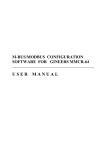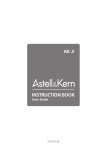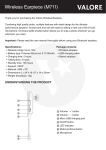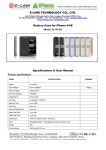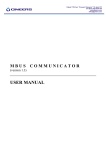Download User manual
Transcript
M-BUS pulse counter MBCS- M-BUS Series User manual MBCS-2/4/6/8 is microcontroller pulse counter with m-bus interface, display and keyboard. Their purpose is to connect in m-bus network devices, which do not have m-bus (usually water- and heat- meters with pulse output). MBCS-2/4/6/8 has embedded real time clock and is capable of tracking four different tariffs. Mounted on a standard М35 DIN-rail. 1. Main technical parameters - number of pulse inputs allowable net voltage nominal power consumption display keyboard max input frequency max cable length max resistance of closed switch min resistance of open switch storage temperature humidity dimensions (H/W/D) baud rate own weight embedded battery additional battery (optional) m-bus default data parameters – 2/4/6/8 – 12-42 VDC – 2 mA (1 and 1/3 standard m-bus loads) – 8 digit symbol LCD – 4 membrane buttons - 5-100 Hz programmable, 10Hz default - 25 m twisted pair (generally depends on cable) - 1 kΩ - 1000 kΩ - -50÷+90 °C - 40÷90 % – 75/70/105 mm (MBCS-6/8), 75/45/105mm (MBCS-2/4) – 300/2400/4800 bps, Odd/Even/No parity, 1 stop bit (2400 8-O-1 default) – 145 g – LiMnO2 60mAh (~7 days), 5 years normal work – Li 1450mAh (~200 days) - 2400bps, 8-O-1 2. Turning on and setting MBCS МBCS is turned on by pressing button “OK” from the keyboard. User will see sign “GINEERS”. Date is set to 01.01.2000, time to 00:00h, pulses storage and tariff information are zeroed. Device enters normal mode of operation and starts to count any pulses on all of its inputs independently. Setup can be made through m-bus network using some kind of m-bus software (if the device is not locked) or through service menu. Primary network address of any MBCS can be set by three ways – special DIP-switches on board, m-bus commands or through service menu, keeping in mind that the first address change through the network locks DIP-switch change further on. Service menu of MBCS For entering the service menu user must press simultaneously buttons ‘↑’ and ‘↓’ for about 2s when display is showing sign “ОСНОВНО”. First parameter to set will appear on the screen. With keyboard buttons ‘↑’ and ‘↓’ user can choose which parameter to set, button “OK” enters in redaction mode, button “NO” exits from service menu. All parameters are kept in non-volatile memory. Parameters, which can be set, are as follows: - ID: Device identification number (secondary addressing also) Identification number of the device is unique 8-digit number for every manufactured instrument. ID can be change by the user either from service menu or with suitable software. Changing is made from most significant to least significant digit. Change of a digit is made with arrows, button “OK” saves the change and goes to the next digit. Currently changing digit is noticed by the means of decimal point on the display. After least significant digit is saved user will automatically return one step behind in the menu and can choose another parameter. - ADDR: Primary network address Primary network address is unique number from 1 to 250 for every device in m-bus network. This address is the parameter, telling central collecting point how to connect with this particular device. Because MBCS has several pulse inputs (max 8) every pulse input is threat like separate device in the network. This means that if the user changes network address he in fact changes the address of the first pulse input, others are set automatically by the MBCS. Using ‘↑’ and ‘↓’ user can choose primary address for the first pulse input. Button “OK” saves the new address and returns the user to service menu. As said previously, other pulse inputs addresses are set automatically by MBCS firmware., incrementing first input address. - BATTERY: Check voltage of the embedded battery Both batteries voltages are shown in numerical decimal value. To see exact voltage user must divide this value to 51. With button “NO” user can exit this parameter. - LOCK: Locking service menu This parameter has two values – “on” and “off”. If the user choose to turn on locking then service menu will be no longer available. This is usually made after all setting is finished, for security reasons. - TURN OFF: Turning OFF MBCS device This parameter has two options – “Turn on” and “Turn off”. Selecting “Turn off” MBCS will shut down and stay in power down mode (minimal consumption). This is used when transporting the device or when the device is mounted, but no m-bus network is provided yet. User menu of MBCS User menu of MBCS is made to show customer accumulated values and eventually cost of consumption (if tariffs are defined). Entering this menu is done by pressing button “OK”. User will see sign “ОСНОВНО”. There are from three to nine menus, depending of MBCS type (pulse inputs) – “ОСНОВНО’ and one for each pulse input parameters (pulse input number is displayed and also if programmed - measured quantity). In every sub-menu user enters by pressing button “OK” and exits by pressing button “NO”. Sub-menus are displayed by pressing buttons ‘↑’ and ‘↓’. If users do not press any key for 30s display will turn off automatically to save power. Sub-menus of “ОСНОВНО”: - DATE: to check current date (dd-mm-yy) - TIME: to check current time (hh-mm-ss) - ADDR: to check current primary network address (ADDR 019) - ID: to check current identification number of the device (12345678) Sub-menus for every pulse input (user will see pulse number – 1to 8 and quantity, if programmed). Currently the following types of pulse instruments can be programmed to MBCS device: water meters for cold and hot water, energy meters, heat- and cold meters, gas flow meters. - UNIT/PS: to check pulse units (liters, Wh, J, etc.), If constant is programmed it is shown too - P TOTAL: to check all accumulated pulses for this input - P TAR1: to check all accumulated pulses for tariff 1 - P TAR2: to check all accumulated pulses for tariff 2 - P TAR3: to check all accumulated pulses for tariff 3 - P TAR4: to check all accumulated pulses for tariff 4 - TARIFF 1: to check cost of tariff 1 (in currency) and time interval for this tariff. Cost is for one pulse - TARIFF 2: to check cost of tariff 2 (in currency) and time interval for this tariff. Cost is for one pulse - TARIFF 3: to check cost of tariff 3 (in currency) and time interval for this tariff. Cost is for one pulse - TARIFF 4: to check cost of tariff 4 (in currency) and time interval for this tariff. Cost is for one pulse - TOT SUM: total cost in currency for this device from beginning till now * - LAST SUM: total cost in currency for this device from previous readout till now * * - this sum values are not provided for the person, who will actually charge and calculate consumption. They are intended for the end user, so he can see how much he consumes and what is roughly the cost for him. The accuracy of programmed cost value for pulse is 1/1000 from the value of national currency (USD, EUR, BGN), so small errors according to rounding can happen. 3. Mounting and wiring МBCS can be mounted either on standard М35 DIN-rail or on a wall. All connections should be made with isolated wires 0.25mm2÷2.5mm2. Wiring is shown Figure 2 and are as follows: No. TB Description 1, 3 m-bus 2 Not used 4+, 56+, 78+, 910+, 1112+, 1314+, 1516+, 1718+, 19- Non-potential Non-potential Non-potential Non-potential Non-potential Non-potential Non-potential Non-potential pulse pulse pulse pulse pulse pulse pulse pulse input input input input input input input input 4. Putting MBCS in exploitation • • • • • • • 1 2 3 4 5 6 7 8 (NC, (NC, (NC, (NC, (NC, (NC, (NC, (NC, if if if if if if if if not not not not not not not not used) used) used) used) used) used) used) used) step 1: МBCS must be unpacked and opened. If the battery (batteries) is (are) not mounted first thing to do is to place battery in its working position. After that MBCS must be turned OFF like described in previous paragraph, then turned ON again by pressing button “OK”. step 2: the user sets primary network address using service menu step 3: turn OFF MBCS from the service menu step 4: mount MBCS mechanically step 5: connect pulse cables to pulse inputs of MBCS step 6: connect m-bus cable step 7: after all m-bus network is ready and have m-bus master is turned on, parameters of every MBCS must be programmed separately. This includes: o communication parameters changes (if needed) o ID number change (if needed) o Set of exact time and date o Setting type of pulse device for every pulse input (water, heat, energy, gas, etc.) o Setting pulse unit and pulse length, if needed o Setting tariffs (up to four different time tariffs (if needed) o Locking the device after all programming and setting is done The system is ready for normal work. Battery life is at least five years from date of turning on the device. Normally it will last longer. Anyway, we recommend replacing battery (batteries) every 5 years. IMPORTANT: After locking the device user can not change any more primary network address. Also, he can’t turn OFF the device or change important parameters of MBCS. All this is made for security reasons, to make sure no one can manipulate the device. 5. Pulse inputs and pulse counting МBCS can have from 2 to 8 independent pulse inputs for counting external pulses. Every input must be taken in mind as independent device with own parameters and network address. For every pulse input user can program type and value of measured quantity, cost and time interval for up to four different tariffs. User can set also multiplier or divider for the pulses and tariff cost in national currency (for now only USD, EUR and BGN). Pulses are accumulated in five memory areas – one for total pulses for each input and four for total pulses for each tariff. Accumulated pulses can only be read – no one can write or change pulse count neither total pulses nor tariff pulses. Maximal frequency of input pulses is programmable from 5Hz to 100Hz. If pulses are with bigger frequency it is likely counting to be incorrect (usually less counted pulses than real one). Default value is 10Hz – i.e. pulse with 100ms period. Pulses usually come from non-potential contact or optron switch, in most cases reed relay. Minimal resistance of open circuit must be around or greater than 1MΩ, maximal resistance of closed switch must be less than 1kΩ, to guarantee correct pulse counting. Distance between contact and MBCS must not exceed 25m (if optron pulse output – about 2m), it is good to use twisted pair for connection cable. If pulse output is optron switch the user must track the polarity of the signal. When reaching pulse count of 99999999 every of the counters (including tariff counting) “overloads” and starts to count from 0. 6. Warranty The warranty of the device is limited to 3 years from the date of sale. If the device shows any defect or malfunctions during that period, the manufacturer is obligated to repair the device in its own service for manufacturer’s expense, or, if the repair is impossible, to replace the device with new one. The transportation costs to the manufacturer’s service are due to the client. The warranty voids if this manual’ instructions are not met, warranty seals are removed or the device was opened by unauthorized by the manufacturer personnel. Serial number:.................... Sale date:........................... Sign:........................... (if no date of sale, date sale becomes production date, coded in device serial number. If no serial number – no warranty) 7. The package contains MBCS - 1 pcs. User manual - 1 pcs. 8. Manufacturer Gineers Ltd. 18 Kliment Ohridski blvd, office 613 1756 Sofia, Bulgaria phone/fax: +359 2 975 81 05 URL: http://www.gineers.com mailto: [email protected]


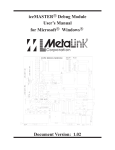


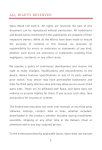
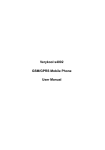
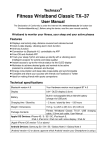
![[ENG] – User Manual – Hammer 2](http://vs1.manualzilla.com/store/data/005660577_1-e32ef60d54b8720b57dfb511ee785652-150x150.png)

